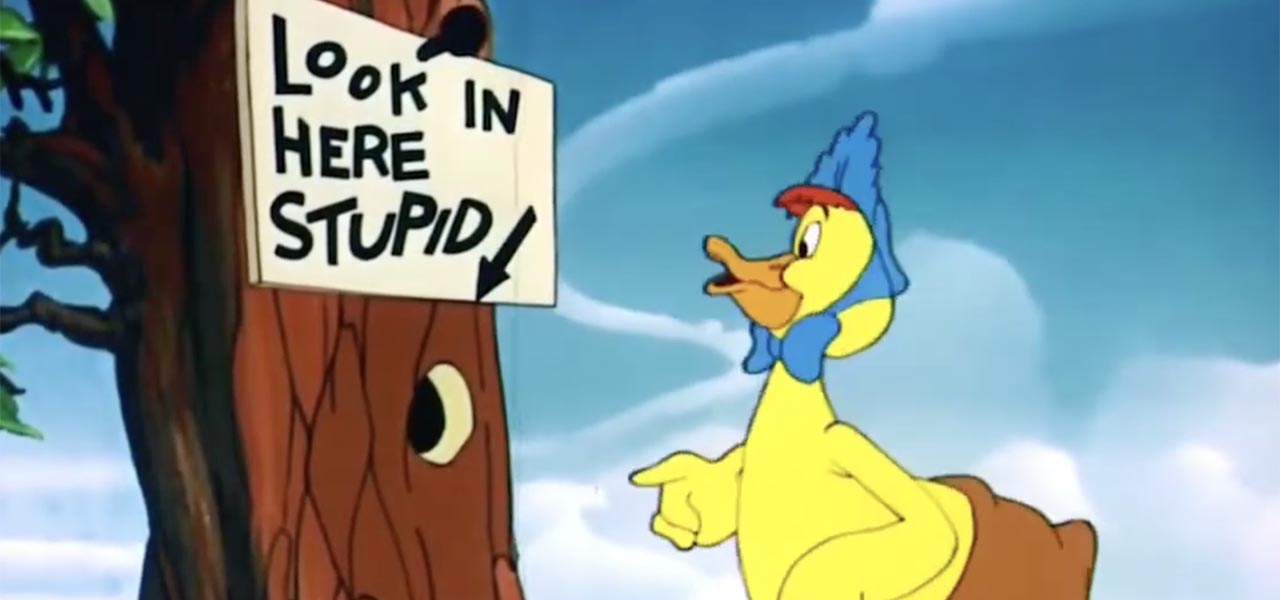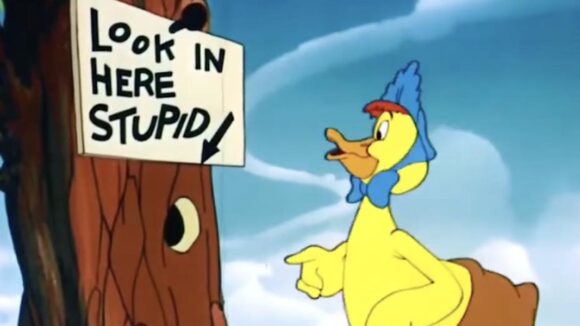

Cartoon Quackers: A Look At Ducks Throughout Animation History
Illumination’s new animated movie Migration stars a family of ducks flying south for the winter. To celebrate its release, we’re taking a look at some of our favorite ducks throughout cartoon history.
We have to start things off with the greatest duck of all, Daffy Duck, who is – in his own words – “just sloppin’ over with talent.” The moment Tex Avery introduced Daffy in Porky’s Duck Hunt (1937), the cartoon world was sent hurtling into a new, more anarchic direction. Here’s Daffy finding a workaround to the whole migration routine in the Robert McKimson classic Birth of a Notion (1947).
— Cartoon Study (@CartoonStudy) December 27, 2023
If Daffy is the best of all cartoon ducks, Donald Duck runs a close second. Clarence Nash first developed Donald’s unique manner of speech on vaudeville, although it was intended to be the voice of a nervous baby goat, not a duck. When Nash auditioned for Disney as an animal impressionist, director Wilfred Jackson recognized something special and switched on the intercom that went directly to Walt Disney’s office. Disney supposedly ran into Jackson’s office and exclaimed, “That’s our talking duck!” With the emphatic exception of Fleischer characters like Popeye and Betty Boop, most cartoon stars of the early 1930s were plucky mischief-makers with generic falsetto voices; Donald’s unique voice and short fuse instantly set him apart and established a precedent for cartoon characters with personalities as readily identifiable as the best live-action comedians. Here’s a prime Donald scene from Billposters (1940), featuring some great acting by animator Ed Love.
— Cartoon Study (@CartoonStudy) December 27, 2023
Lots of studios tried their own spin on Clarence Nash’s duck voice. One of the oddest attempts is Duckie Wuckie, a duck caricature of Mae West, who appeared in the Max Fleischer short Chicken a la King (1937). Jack Mercer, the voice of Popeye, trying to sound like a mallard seductress (se-duck-tress?) results in one of the weirdest vocal performances of all time.
— Cartoon Study (@CartoonStudy) December 27, 2023
Tex Avery did some duck hunting in his spare time, and he seemed to get a kick out of ridiculing his own hobby. Avery’s brilliant MGM short Lucky Ducky (1948) stars a wacky waterfowl that heckles two dopey hunters in a frantic series of increasingly surreal gags.
— Cartoon Study (@CartoonStudy) December 27, 2023
Speaking of MGM ducks, let’s not forget Quacker, a self-pitying little yellow duckling who appeared in a number of Tom & Jerry shorts. Quacker’s voice was provided by nightclub comic Red Coffey. Here he is in his debut short Little Quacker (1950).
— Cartoon Study (@CartoonStudy) December 27, 2023
William Hanna and Joseph Barbera must’ve been fond of Quacker, because they brought him back for tv, only now voiced by Jimmy Weldon and rechristened Yakky Doodle. Yakky starred in his own segment on The Yogi Bear Show, and was often teamed with colorful antagonists like Alfy Gator, a spoof of director Alfred Hitchcock.
— Cartoon Study (@CartoonStudy) December 27, 2023
Baby Huey, a gargantuan young moron created by animator Marty Taras, starred in thirteen theatrical animated shorts in the 1950s. Huey’s cartoons are a prime example of Famous Studios’ signature blend of saccharine cuteness and almost bloodthirsty cartoon violence. I tend to think of Huey as a slightly obscure character, but maybe I’m wrong; he was popular enough to score a 1990s reboot The Baby Huey Show, and he was even name-dropped by U.S. President Bill Clinton, who once said, “I’m a lot like Baby Huey. I’m fat. I’m ugly. But if you push me down, I keep coming back.” Here’s a scene from Huey’s debut, Quack-a-Doodle-Doo (1950).
— Cartoon Study (@CartoonStudy) December 27, 2023
The Terrytoons studio had their own duck character, the adorable Dinky Duck, who appeared in several cartoons throughout the 1940s and ’50s. These films were strictly routine until Dinky’s final appearance, It’s a Living (1957), where directors Gene Deitch and Winfield Hoskins completely demolished the formula by having Dinky get fed up with his own series and quit the animation business altogether! This beautiful Cinemascope print comes from Steve Stanchfield.
— Cartoon Study (@CartoonStudy) December 27, 2023
Forbes ranked Donald’s miserly uncle Scrooge McDuck as the richest fictional character of all time, estimating that his worth is $65.4 billion. I’m not sure where they came up with that number, as Scrooge’s creator Carl Barks once claimed that Scrooge’s fortune adds up to one multiplujillion, nine obsquatumatillion, six hundred twenty-three dollars and sixty-two cents. Scrooge made his first comic book appearance back in 1947, and he has gone on to appear in various animated shorts, tv series, and feature films. His best known film role is the holiday classic Mickey’s Christmas Carol (1983), but his animation debut was in the little-seen educational short Scrooge McDuck and Money (1967). Scrooge is performed here by Bill Thompson (the voice of Droopy), doing the same Scottish brogue he used for Jock in Lady and the Tramp.
— Cartoon Study (@CartoonStudy) December 27, 2023
Donald’s girlfriend Daisy and his nephews Huey, Dewey, and Louie made frequent appearances in the classic theatrical Disney shorts, but various other residents of Duckburg have subsequently been added to the DDEU (Donald Duck Extended Universe). One of my favorites is Ludwig Von Drake, a Viennese pseudo-intellectual voiced by Paul Frees, who frequently appeared on Walt Disney’s Wonderful World of Color in the 1960s to lecture about science, art, child psychology, etc. Watch Ludwig go to town in his only theatrical short, A Symposium on Popular Songs (1962), in a scene animated by Ward Kimball.
— Cartoon Study (@CartoonStudy) December 27, 2023
Disney Television Animation has continued to ride the duck train with animated series like DuckTales, Quack Pack, Mighty Ducks: The Animated Series, and Darkwing Duck. This intro to the two-part Darkwing Duck pilot from 1991 features some impressively fluid and expressive animation.
— Cartoon Study (@CartoonStudy) December 27, 2023
Like Donald, Daffy has inspired his share of spin-off characters. Plucky Duck from Tiny Toon Adventures is essentially a younger version of Daffy, but Plucky’s spaced-out love interest Shirley the Loon (who speaks in a Valley Girl accent provided by Gail Matthius) is a fun new addition.
— Cartoon Study (@CartoonStudy) December 27, 2023
Another Daffy-adjacent character: Clarence, star of the canceled live-action/animated movie The Duck, which was supposed to be about a real duck that turns into a cartoon superhero. The film was developed in 1998 by Uli Meyer, who was hot off of his stint as a supervising animator on Space Jam. For some reason, Daffy Duck’s design was used for the test footage, although Clarence presumably would’ve looked different in the finished film. Funding for the movie ultimately fell through, but Meyer’s nine-minute proof-of-concept film is a fascinating curio.
— Cartoon Study (@CartoonStudy) December 27, 2023
Sally Cruikshank’s characters Quasi and Anita are so heavily abstracted that it’s easy to forget that they’re supposed to be ducks, but that all goes along with the off-kilter style of these wonderfully bizarre indie shorts. Here’s a typically weird moment from Quasi at the Quackadero (1975).
— Cartoon Study (@CartoonStudy) December 27, 2023
So many cartoon ducks have appeared in animated tv series for kids, either as the lead characters (Sitting Ducks, Breadwinners) or supporting players (Wade from Garfield and Friends, Le Quack from Courage the Cowardly Dog) that I couldn’t possibly name them all. One that deserves mention is Count Duckula, a macabre British tv series that ran from 1988 to 1993 about a vegetarian vampire duck.
— Cartoon Study (@CartoonStudy) December 27, 2023
And then there’s Duckman, the cult ’90s animated series created by Everett Peck, who sadly died from pancreatic cancer last year. The series was produced by Klasky-Csupo, and it shares the same rough-hewn art style as Rugrats and Aaahh!! Real Monsters, despite being aimed at an older audience. The show’s belligerent lead character Eric Duckman (voiced by Jason Alexander) has some great rants, including this memorable one about the value of comedy.
— Cartoon Study (@CartoonStudy) December 27, 2023
One of the most unsung cartoon fowls is Yuckie Duck, who appeared in a couple of hilarious shorts on Cartoon Network’s anthology series The What a Cartoon! Show. The feverishly insane drawings here are unabashedly cartoony and I can’t get enough. It’s a crime that creator Pat Ventura never got to helm his own animated series. Here’s a scene from Yuckie’s second cartoon I’m On My Way (1995).
— Cartoon Study (@CartoonStudy) December 27, 2023
And that’s just scratching the surface. I haven’t even mentioned the early webtoon Queer Duck or the raunchy X-rated feature Down and Dirty Duck, directed and almost single-handedly animated by Chuck Swenson, who later co-created the Cartoon Network series Mike, Lu & Og.
— Cartoon Study (@CartoonStudy) December 27, 2023
But let’s turn it over to you: who are your favorite cartoon ducks? Let us know in the comments below.
— Cartoon Study (@CartoonStudy) December 27, 2023
